|
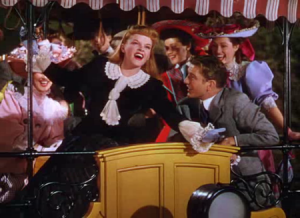
|
| "MEET ME IN SAINT LOUIS" |
"The Trolley Song" - Judy Garland & Mel Torme
"The Trolley Song" - Carol Burnett
"Meet Me in St. Louis" is about events surrounding attending the 1904 Saint Louis World's Fair, via traveling on beautiful
trolleyed streetcars. In 1944, there was never a film that received more celebration due to United States audience's love
affair with their "Trolleys." they took everyday.
The irony is - it premièred 5 years after the 1939 New York World's Fair; where the vision of "Tomorrow" had no trolleys,
no cable cars, no streetcars, no trams, no public transportation at all - only cars.
1939 World's Fair Exhibit: Devoid of public transit - like the big auto and tire executives like.
Who doesn't love Mr. Rogers and his trolley? Watch closely the beginning and end credits. Yes, we can have trolleyed streetcars
again stopping and running right along our houses. We restore what we had, the perfect electric system renaissance!
Charles J. Van Depoele, Inventor of 3rd Rail Electric Tramway - Tramway Information
Overhead Wire Electrification, in other words "Third Rail," the modern invention of Charles J. Van Depoele and Leo Daft is
still superior and commonplace around the world. Fixing structural/infrastructure problems, like every other country has
needed to, is the answer to continued "Third Rail" use, and is considerably less expensive. Energy conversion modes,
such as electric-to-battery-to-electric is redundant, FAR more expensive, continues to enable child slavery and slave wages
for cobalt and lithium mining, engineering brand new types of redundant conversation energy trains, batteries need
cooling systems, and adds several tons of weight to each car, and production of batteries pollutes.
Only, ONLY, if there is no electrification possible should trains run on hydrogen, and it must be "Green Hydrogen" (produced
by Plasma Arc Gasification). ["Blue Hydrogen" and other names are made by converting fracked gas - taking one energy source
only to make another. Gas is a fossil fuel.]
| PIROTSKY'S 1ST ELECTRIC TRAM TESTING PLACE |

|
| MILLER'S RAILWAY LINE IN FINLAND, THEN RUSSIAN OWNED |
Railway Electrification system(s), Electric Trams, and Electric Tramlines were invented
by Ukranian Fyodor Apollonovich Pirotsky.
"Tramline" = "Light Rail" - Wikipedia
Fyodor Apollonovich Pirotsky - Military.com
Streetcar Trolley Music & Folklore

| 1885 BALTIMORE:INVENTION OF THE ELECTRIC STREETCAR |
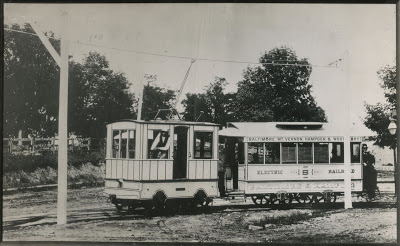
|
| THE FIRST ELECTRIC STREETCAR - BALTIMORE 1885 - Leo Daft |
| BALTIMORE ELECTRIC STREETCAR INVENTOR LEO DAFT |
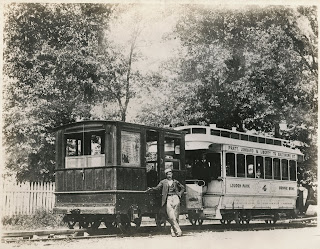
|
| Leo Daft, Inventor posing for picture while still tinkering with his streetcar. |
| SAINT CHARLES STREETCAR IN NEW ORLEANS |
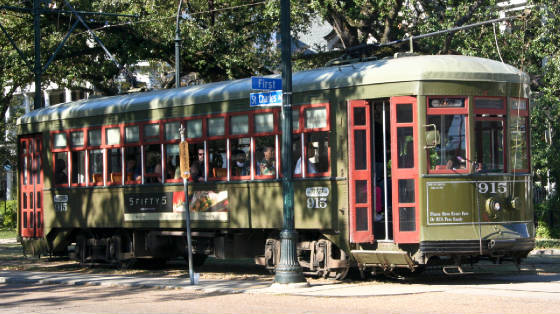
|
| THIS 1934 STREETCAR LINE IS STILL RUNNING - LONGEST CONTINUING LINE |
| THE NORTH AVENUE STREETCAR |
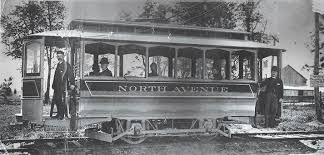
|
| THE NORTH AVENUE STREETCAR |
The Pullman - Baltimore Transit Company Trolley - Gerhard Salomon
Baltimore Transit Company - 1963 Featuring Pullman - Gerhard Salomon Slideshow
"Where riding is heavy, no coach yet developed can carry a passenger as cheaply as a streetcar. No vehicle for surface
transportation... can compete with the modern streetcar for long hauls on heavy traveled lines." - Baltimore Transit
Company Annual Report (1937)
"Streets and highways of cities are fixed and have capacity for moving a definite and limited number of vehicles per hour.
However, the city traffic problem is not the problem of moving vehicles, primarily, but of moving people. One
of our streets with a double-track car line can carry 15,000 people in 1 hour. Without a {street}car line and everybody riding
in automobiles that same street could only handle 1/5 that number per hour. Stated another way, it would take 5 such streets
to handle the same number of people in the same time in automobiles."
Transit Equity: "Will improve service for residents who live in poverty and for households without cars. The system
will be better coordinated across parish lines to reduce redundancy and make transfers between systems easier." - New Orleans
Regional Transit (NORTA)
"Today, we are looking at turning the streetcar into a completely valid mass transit system.
- Michael English, President, Tampa Historic Streetcar Board (December 2020)
St. Charles Streetcar Line - Wikiwand
New Orleans, Louisiana "The St. Charles" The Longest Continuously Running Streetcar in the World Steam, then Horse Drawn 1835
then Electric 1893
Public transportation used to take you anywhere you wanted to go - and quickly. Streetcars had dedicated lanes, even rails
in the sky. If you were however, black, you weren't allowed to go into the suburbs.
Today there is a major regret: so many cities and towns practically and actually begging for trolleyed streetcars;
not just one glorified line for tourists, but for an entire system. Baltimore, where the streetcar was invented, must no
longer fear the gas, oil, and tire companies, as there are even bigger and scarier enemies - global warming, climate change,
tire-leaching chemicals, electric batteries too heavy for roads, bridges, and highways, and escalating respiratory illnesses
and deaths from: asthma, bronchitis, and phenomena. We must because we must; restore our complete electric system,
59 years absent.
| IN PROGRESS OF ORGANIZING THE LINKS |

|
| ALWAYS ADDING INFORMATION |
The Baltimore and Hampden Company signed a contract with Daft to replace the tracks from Charles and 25th Streets in Baltimore
to 40th Street and Roland Avenue in the suburb of Hampden.
"The first commercial electric railway began service in Baltimore, Maryland. Replacing the mule-drawn cars on the Hampden
line, the pioneering system used electricity in a third rail running down the middle of the track to power the cars."
"Today, heritage specials are run regularly on certain lines and have proved very profitable to the modern network,
bringing in at least £30 million annually."
Baltimore Trains and Streetcars (1940s??)
1948 Trains and Trolleys - 1948" NRHS Baltimore Convention - The National Railway Historical Society - Harry Sell (53)
Baltimore: Streetcars & Steam Trains 1950 - The National Railway Historical Society - Harry Sell (136)
"City Market and Trolleys - 1955" NRHS Baltimore Convention - The National Railway Historical Society - Harry Sell (103)
"The Gem of Oldtown" - To Enlighten My People Lacking Enlightenment
"The History of Public Transportation in Baltimore" - Kate Drabinski
"Today 75% of us live in urban areas, so clearly the health of the American city is very much the health of the nation.
And when any city shows signs of any new life and vigor, it's a cause for celebration. Tonight, the city celebrates its
renaissance with a 'Pops' concert by The Baltimore Symphony Orchestra..." - Howard K. Smith
A Virtual Tour of the Baltimore Streetcar Museum
Pictures - General Motors - Monovision
"By 1890, Baltimore had heavier and more reliable vehicles on its streets; the true trolley car being one of them, acquiring
its power from overhead wires and traveling as fast as traffic moves today, sometimes faster."
"Every extra year a child spends in a better environment – as measured by the outcomes of children already living in
that area – improves her outcomes, a pattern we term a childhood exposure effect. We find equal and opposite exposure
effects for children whose families moved to worse areas...
Every extra year spent in the city of Baltimore reduces a child’s earnings by 0.86% per year of exposure,
generating a total earnings penalty of approximately 17% for children who grow up there from birth."
Public transportation used to take you anywhere you wanted to go - and quickly. Streetcars had dedicated lanes, even rails
in the sky. If you were however black, you weren't allowed to go into the suburbs.
Today there is a major regret: so many cities and towns practically and actually begging for trolleyed streetcars; not just
one glorified line for tourists, but for the entire system. Baltimore, where the streetcar was invented, must no longer fear
the gas, oil, and tire companies, as there are even bigger and scarier enemies - global warming, climate change, and escalating
respiratory illnesses and deaths from: asthma, bronchitis, and phenomena. We must because we must; restore our complete electric
system, 59 years absent.
"Junction Renewal" - How Tracks Are Made - London Midland & Scottish Railroad Company
"A Study in Steel" (1935)
"Wash Up and Brush Up" - Steam Locomotive Maintenance - British Transport Films
"Day-To-Day Track Maintenance Part I: Plain Line" - British Transport Films (1952)
"Day-To-Day Track Maintenance Part II: Switches & Crossings" (1952)
Just like the installation of streetcar tracks, development returns as fast as the tracks are newly installed.
"360 VIDEO: Watch How Cars Along Route of Kansas City Streetcar Bring the Streetcar to a Halt" - Kansas City Star
Tramways & Urban Transit: Light Rail Magazine
| GUILFORD "EL" STREETCAR: CHASE <--> LEXINGTON. |
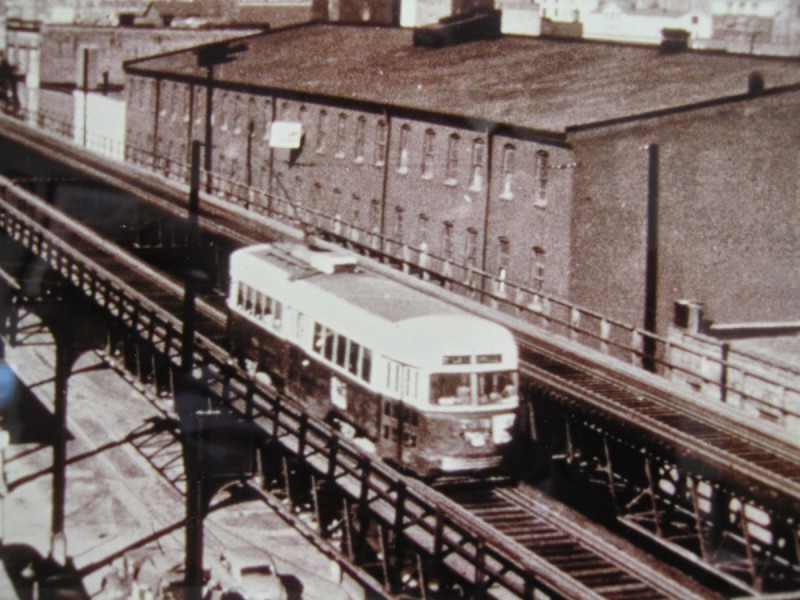
|
| THE GUILFORD LINE -ELEVATED 1893 - 1950 |
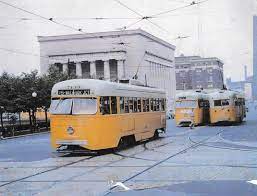
"Economic activity seems to spring up around streetcars in other cities that have them. Just being able to see the routes
means something to the riders and the businesses." - Michael Blumberg
"Why TrolleyBuses are vastly Superior to Battery Electric Buses!
"The Highway Where Trucks Work Like Electric Trains" - Tom Scott
"Are these self-charging e-highways the future of transportation?' - RAZOR Science Show
Cablecars ~ Streetcars ~ Trolleys ~ Aerial Cablecars
"Conduit Division" - Baltimore City Department of Transportation
| A TRUE POSSIBILITY - NATURE SURROUNDING TRACKS |
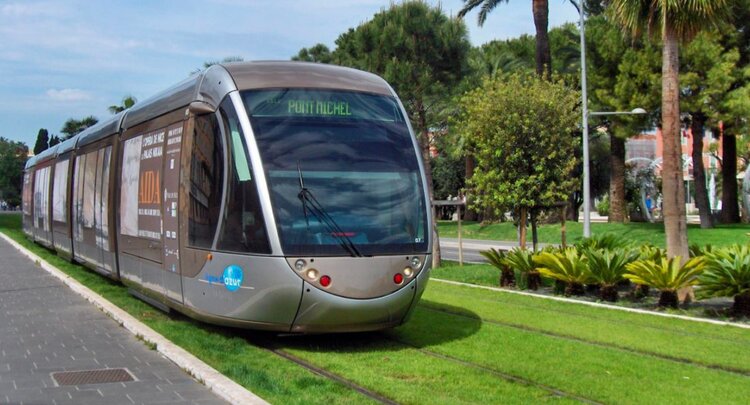
|
| Atlanta Rendering - BELTLINE NOW! |
BALTIMORE: "In Nod to History, Some Call for Return of Streetcars" - Capitol News Service (2014)
Baltimore Streetcar Campaign
Baltimore Transit Campaign - Status
"New Transit-Funding Rules Make Streetcars More Desirable" - Wall Street Journal (2010)
"The Failure and Success of Great American Transit | Light rail" - Big MoodEnergy [West Coast Oriented]
...........................................................................................................................................................................................................................................................................................................................
1. Streetcars fix "Car-Dependent" City Areas & Suburbs
"Suburbs that don't Suck - Streetcar Suburbs (Riverdale, Toronto, Canada)" - Not Just Bikes
"How Streetcars were used to sell land - Creating suburbs through "destination" activities and parks - Big MoodEnergy [Start
at 2:00] [West Coast Oriented]
2. Economic Renaissance: Streetcars offer foot traffic to direly struggling businesses that have not have it in decades, and
offer new businesses to sprout. Increasing foot traffic makes places attractive, desirable, and have safety in numbers.
Investment by Baltimore choosing dedicated lane streetcars brings tax dollars to every part, every neighborhood of the city.
Kansas City, Missouri celebrates their customers having free transportation service to their doors. "Every time the
streetcar passes, we get a new wave of people so I feel it's very beneficial for us." - Bianca Augafa, Bloom's bakery.
3. Mobile Independence: Wheelchair, walker, and cane users are happy with streetcars as they can roll and walk at
street level directly into the streetcar, making it the fastest boarding public transit - forever. Buses have either steps
or a ramp that has to be kneeled, lowered, folded out, then raised and retreated back into the bus. Then the wheelchair user
needs to be belted in if no wheelchair brakes, or are deemed inadequate. This takes a lot of time.
4. Predictable. Baltimore Orioles baseball game letting out? No problem. Streetcars have dedicated lanes, so your
trolley will be on time. Forget all those hours waiting. There is no traffic anymore. Faster than buses, more convenient
and accessible routes than light rail, a comprehensive streetcar system could be a game changer in getting around Baltimore
without a car.
"It's pretty clear where Seattle's streetcar lines need improvement. Seattle's streetcar routes need more exclusive lanes,
longer routes, better transfer points, and routing through neighborhoods underserved by current and planned
higher-speed subway lines."
5. Upscale Experience: Streetcars still have an aura of elegance and grandeur. You have the choice of sitting or standing,
and can still easily get off at your stop. [On a bus you are often in the middle of the bus, confined, and have to practically
scream as you are attempting to get around an overcrowded bus.] but not be squashed the experience. Streetcars are more
comfortable, smooth due to its rails, and quiet, as there is no motor.
6. World Class Transportation: When people come to cities, especially from Europe, they have an expectation to get around
just like at home: fast trams, streetcars, trolleys, and cable cars. This is an amenity that makes people stay a few days
in Baltimore, as they realize just how much more there is to see rather than the segregated Charm City Circular, like the
Great Blacks Wax Museum, rather than scurrying quickly to Washington D.C.
7. Mobility: Faster than buses, more convenient and accessible routes than light rail, a comprehensive streetcar system
could be a game changer in getting around Baltimore without a car.
8. Streetcars are comfortable, easy to quickly get in and out of due to being at curb level
9. Working Class / Workforce. More people are going to expect streetcars as a transportation mode and as an urban
amenity in larger cities. We shouldn't be left out.
11. Tourism. Tourists are more likely to take a streetcar to a museum or to the Inner Harbor than they would a bus.
Streetcars would also attract more choice riders. Though MTA buses are fine vehicles, fixed rail transit is a more comfortable
ride with straight-forward routes which encourage out of town riders.
12. Less maintenance.
13. Electric Only. Electricity can be made via geothermal continuously, and with passive hydropower, solar, and wind.
This is the only true zero carbon emission, non-child and slave labored fueled (EV batteries) transportation. [Hydrogen-powered
trains are still in testing stage.]
"How to Build Better Streetcars" - RM Transit
"How to Spruce Up Your Tracks: The Magic of Green Track" - RM Transit
"Portland's streetcars were actually cheaper and more productive than the city's bus service... Still, Portland's streetcars
'would be middle performers if they were bus routes. But nobody gets excited about buses.'" - Jeff Brown Professor and
Streetcar critic.
- History Trails
| IN PROGRESS OF ORGANIZING THE LINKS |

|
| ALWAYS ADDING INFORMATION |
| NEW ORLEANS |
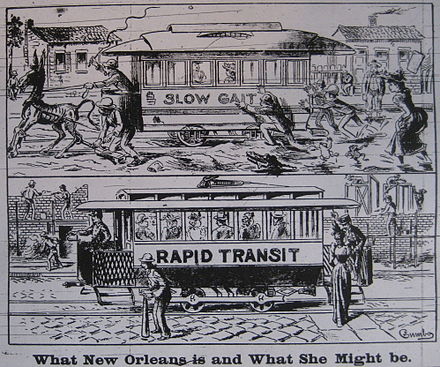
|
| October 21st, 1893 |
Library of Congress: Baltimore Streetcars Collection
Library of Congress: Baltimore Trolley Collection
|
